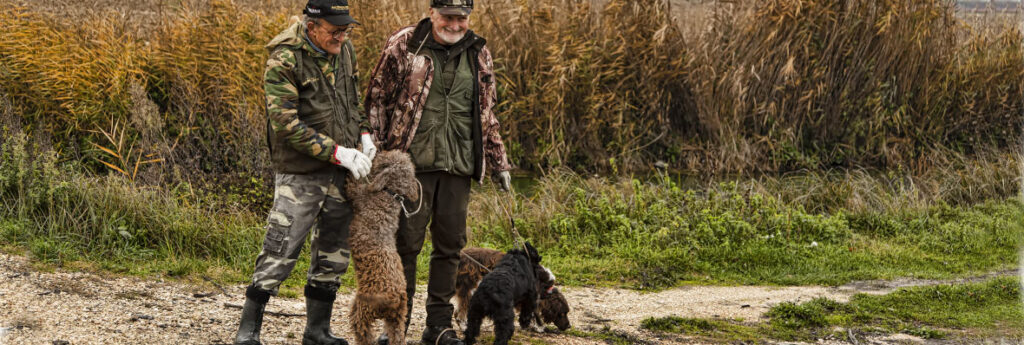I’m walking through Pettino’s truffle-rich forests and pastures at the base of a mountain. Leading the way are four specially trained dogs – Pucci, Pippo, Vespa and Enea – and hot on their heels are the truffle hunters Luciano and Bruno, armed with small picks and a leather bag for the loot.
Truffle hunting is a centuries-old daily tradition in Umbria. “It’s an everyday part of our lives,” says Bruno. “We go out almost every day. We are the caretakers of the truffle mountain and forests, and the keepers of many generations of recipes. We eat truffles, we produce condiments from them, we sell them. This is how we live.” It’s a beautiful and simple way of life – the secluded Umbrian mountains, the ancestral hamlet that’s been home to truffle hunters since the 15th century.
Today, next to the river, we’re in search of white truffles, the rare bulbous tuber that cannot be cultivated in the same way as its black counterpart. Pucci disappears into the undergrowth, quickly followed by Bruno, her handler. He produces his vanghino, a specialist excavation tool, and unearths an onion-size white truffle. This excites Pucci as she knows what’s coming – a treat in the form of some dried pasta.
Truffles exude a chemical that imitates the mammalian reproductive pheromones, so for an animal, just sniffing it is akin to being drugged. Initially, female pigs were used to find truffles, but when they latch onto its aroma, they’re driven wild and often end up eating their finds. This gave rise to the training and use of truffle-hunting dogs, usually traditional water breeds such as pointers, spaniels and setters, which by law must be highly trained. In theory, they can be of any age, although the best results are attained in three- to six-month-old pups.
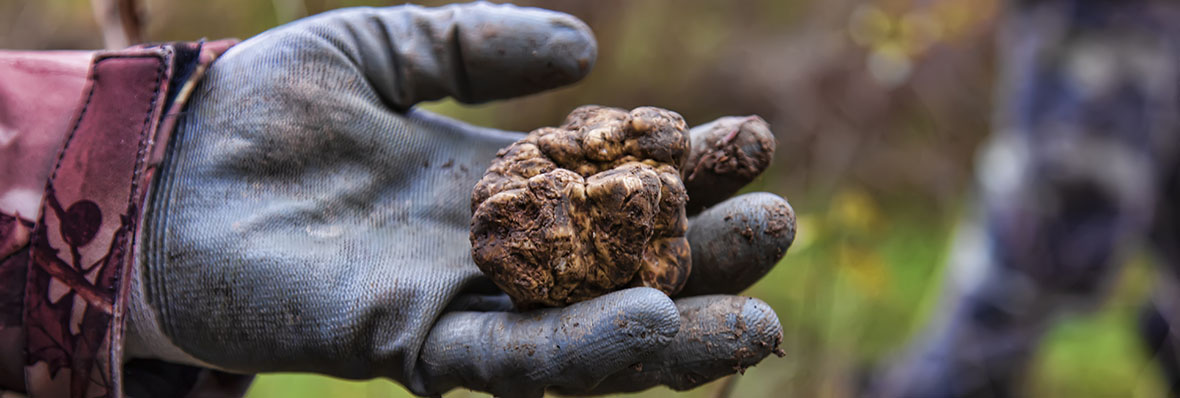
Bruno has just started telling me about the price per kilo for black truffles – in excess of £250 – when he hears frantic digging among the trees and sets off in search of Pippo. Moments later, he emerges from beneath the undergrowth, holding an egg-size white truffle between his thumb and index finger. “This,” he says, “is ten times the value of black truffles.” He hands it to me, and I feel its weight in my palm, smell its luscious, slightly garlicky scent, which Bruno tells me is ideal for enhancing the flavour of any dish.
We find just a handful of truffles in our hour-long trek, so the dogs are transported to the nearby estate of San Pietro a Pettine, which is higher up the mountain. Here, we’ll set out to find black truffles, which are buried among roots in select patches of hillside oak and hazelnut groves.
Umbria is the single largest producer of truffles in Italy. In meeting the worldwide demand of international chefs, professional truffle hunters can earn up to £20,000 a season, passing their finds through a series of highly competitive and carefully guarded truffle-market channels before reaching their destinations abroad.
Today, however, our truffles are only going as far as the estate’s restaurant, La Cucina, where the chef Alicia Capuricci uses them to prepare a delicious lunch for us. We start with an egg that has been slow poached for 90 minutes, coated in panko, deep-fried, then served atop creamy mashed potato. This is accompanied by a parmigiana fondue and a heavy handful of white truffle shavings (the very ones we have just brought in from the woods), which taste oaky, nutty and a little earthy, with back notes of olives. “Black truffles’ spores smell stronger than the flavour, but even the strongest will never overpower other ingredients on the plate,” says Alicia, who uses the fungi like a vegetable, shaving it onto just about anything – including ice cream.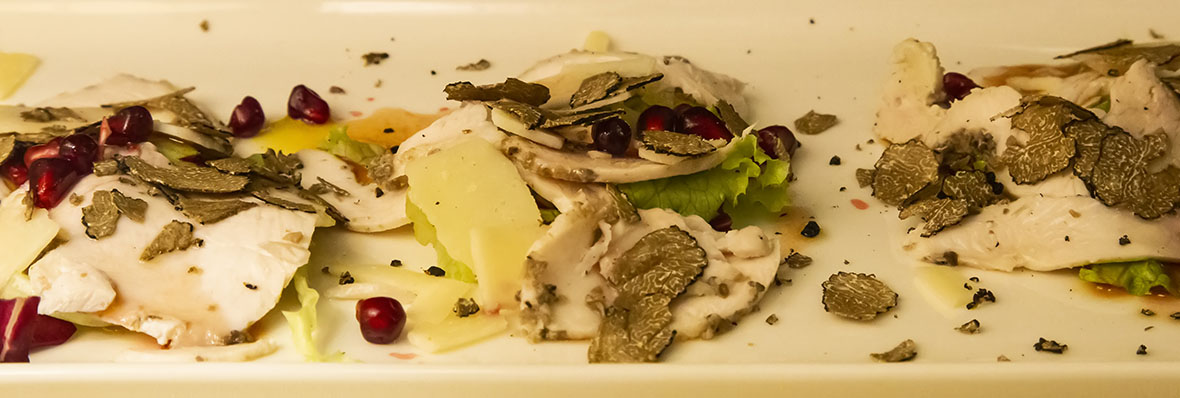
Later, at La Pintura, my farmhouse retreat near Trevi, Nonna Ciarletti is making dinner. I’m sitting at a battered 10-seater wooden table, beside a slow-burning log fire, in the company of Gianfranco Ciarletti, my host and a fourth-generation olive farmer. Together, we dine on a harmonious mix of brochettes of meat toasted on open coals, wafers of cured ham, topped off with lashings of home-grown olive oil. Then the soul food makes an appearance – a dense vegetable broth with a fistful of grated truffles and a liberal sprinkling of parmesan cheese, plus a good glug of olive oil. Silence descends on the farmhouse as we lose ourselves in truffle heaven…
Umbria: the ultimate foodie guide
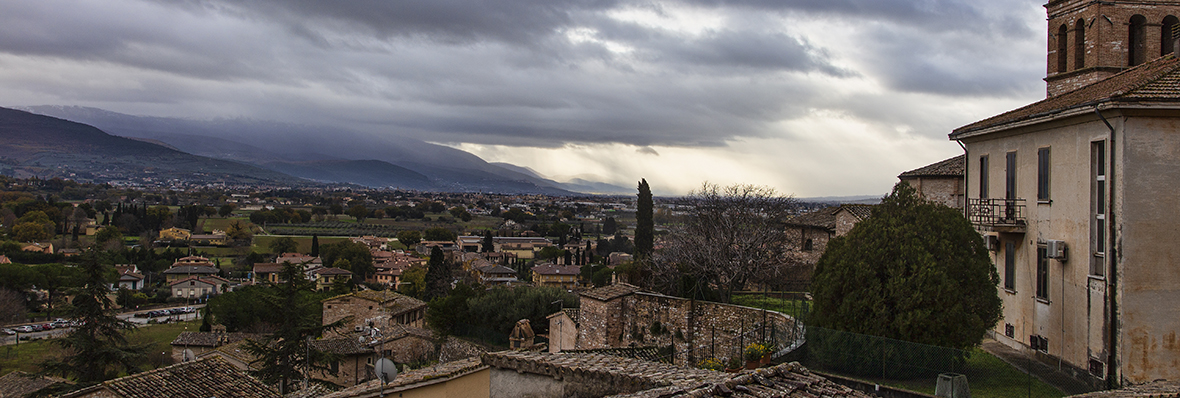 Where to make traditional pasta: In the picture-postcard village of Scheggino, clamber down a flight of narrow stone steps to Restaurant Osteria Baciafemmine, where the chef Elisa Valentini will demonstrate the pasta-making process to interested visitors. “The region’s typical pasta is umbrici, made from flour and water,” she explains. “After kneading the dough, it is rolled out, then hand-cut into a cord-like spaghetti strips. Of course, the ideal condiment for our umbricelli is truffles.”
Where to make traditional pasta: In the picture-postcard village of Scheggino, clamber down a flight of narrow stone steps to Restaurant Osteria Baciafemmine, where the chef Elisa Valentini will demonstrate the pasta-making process to interested visitors. “The region’s typical pasta is umbrici, made from flour and water,” she explains. “After kneading the dough, it is rolled out, then hand-cut into a cord-like spaghetti strips. Of course, the ideal condiment for our umbricelli is truffles.”
Where to celebrate truffles: On 4 and 5 April, Scheggino plays host to the Diamante Nero festival. Browse stalls groaning under the weight of fresh truffles, buy truffle marmalades, oils and other condiments, sample local products such as cheese, lentils and saffron, and discover traditional crafts such as handwoven fabrics. There are also numerous cooking demonstrations and tastings, and hands-on activities for kids, but the highlight of the weekend is attempting to set a Guinness World Record for a giant truffle frittata.
Where to learn more about truffles: Visit the Museo del Tartufo Urbani in Scheggino to delve into the history surrounding its ‘black diamonds’; and while you’re there, stock up on all your truffle requirements in the excellent museum shop.
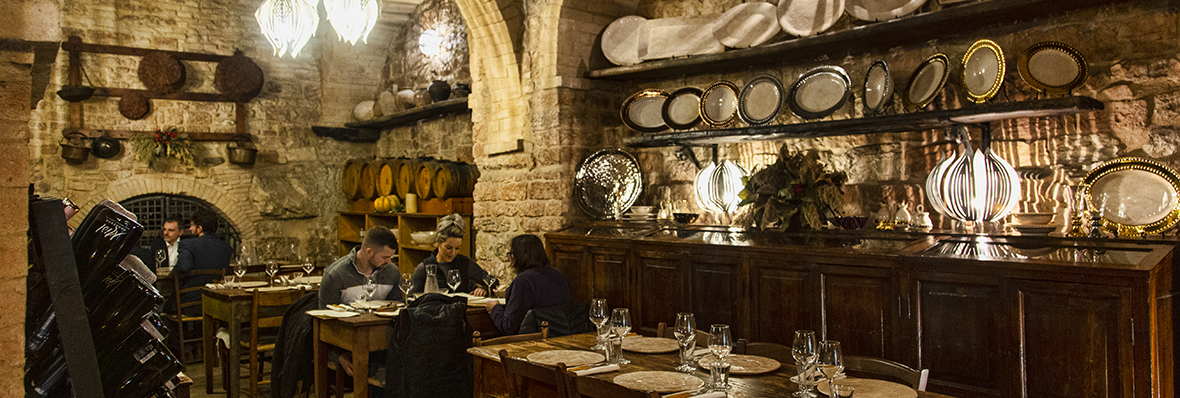 Where to stay: Castello di Monticelli, near Perugia, is a preserved sixth-century fortress turned boutique hotel festooned with mediaeval characteristics in each of its 26 suites – expect fireplaces, terracotta floors, oak ceiling beams and chestnut windows that frame views of the valley and Perugia in the distance. It’s surrounded by two acres of gardens and terraces; six acres of forest and a large patch of land where organic produce is grown. Alternatively, for a more rustic experience, stay at La Pintura, which offers refined farmhouse-style accommodation on a working olive farm. On offer are four comfortable en-suite rooms, dressed in handmade bed linens and curtains.
Where to stay: Castello di Monticelli, near Perugia, is a preserved sixth-century fortress turned boutique hotel festooned with mediaeval characteristics in each of its 26 suites – expect fireplaces, terracotta floors, oak ceiling beams and chestnut windows that frame views of the valley and Perugia in the distance. It’s surrounded by two acres of gardens and terraces; six acres of forest and a large patch of land where organic produce is grown. Alternatively, for a more rustic experience, stay at La Pintura, which offers refined farmhouse-style accommodation on a working olive farm. On offer are four comfortable en-suite rooms, dressed in handmade bed linens and curtains.
How to get there: Get a flight to London Heathrow then a cheap connecting flight either via Ryanair, which flies to Perugia three times a week from London Stansted Airport; alternatively, later this summer, British Airways will launch a new route from Heathrow.

